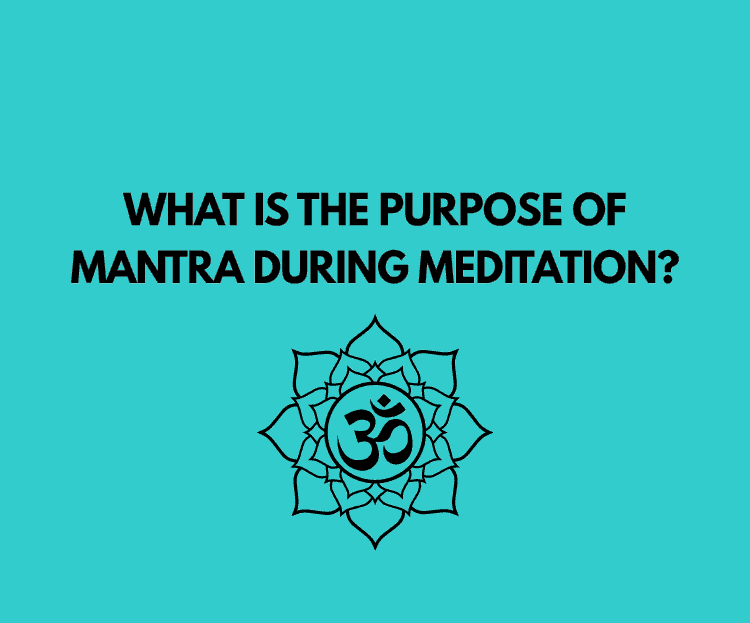
Mantra is a Sanskrit word that means ‘the key to your mind’. ‘Man’ (or MUN) in Sanskrit translates to, ‘Mind’ and ‘tra’ roughly translates to, ‘the essence’, ‘the key’, ‘the root’ or ‘to liberate’. So a mantra is essentially a sacred word(s) or sound that has the power to transform your mind.
So why do we use a mantra during meditation? A mantra helps you maintain focus during meditation. In addition, a mantra can also help reprogram your mind to a more desired state and even aid necessary healing or manifestation being sought.
So the mantra has a threefold purpose in meditation. Let’s look at these in detail.
What is the purpose of mantra in meditation?
1. A mantra helps you focus
The main purpose of using a mantra during meditation is to help focus your attention, which admittedly is not always easy – especially if you’re a beginner. Taking hold of your wandering mind can ultimately help you gravitate towards deeper levels of consciousness.
During meditation you would make use of a mantra repeatedly (generally out loud) while focusing your attention on the sound and/or vibration created by the particular word, sound or phrase that you have decided is best for you.
2. A mantra acts as a subconscious affirmation
A mantra can also act as an affirmation, and when repeated over and over it helps to recondition your subconscious mind with whatever positive message you are trying to convey.
While meditating, your thoughts subside and you are in a state of deep relaxation. This helps anchor the message more easily in your subconscious mind.
You can develop or use mantras related to the areas of your life in which they are most needed — for instance, it could be something such as ‘Love’, ‘Be open’, or ‘I Am whole’, ‘I Am positive’, ‘I am successful’, I Am powerful’, ‘I Am the conscious creator of my own reality’ etc.
3. Mantras help healing and restoration
In many schools of meditation and other practices such as Yoga and Reiki, vibrations and sound are also considered to have healing properties. Ancient sound healing techniques are familiar to these practices, where specific frequencies of tone are employed in order to realign the body into a state of vibrational balance.
When you chant a mantra properly (for example, chanting OM), the resonant sounds permeate deep into your system and help you return to a state of balance and harmony, through the opening and clearing of chakra systems (which as essentially energy centers in your body).
In-fact, there are specific mantras for each chakra to help you heal and balance them.
Examples of Sanskrit and Buddhist mantras
Now that you know the purpose of chanting a mantra during meditation, let’s look at some popular Sanskrit and Buddhist mantras that have powerful healing properties. In addition to healing, these mantras can also help dispen negative energy and attract positive energy into your being and surroundings.
1. OM or AUM
OM is a sound/word that is considered the holiest of all holy words, the origination of all names and forms – the eternal OM – from which the whole universe may be supposed to have been created.
When pronounced properly, OM is said to represent the complete phenomenon of the production of sound unlike no other, being the primary manifestation of Divine Wisdom symbolic of God. OM is the symbol of the Three in One. The three sounds (or syllables) contained in Om or AUM are ‘AA’, ‘OO’ and ‘MM’.
These are said to represent the three worlds in the Soul – past, present, and future, in Eternity; the three Divine Powers – Creation, Preservation and Transformation; the word and the symbol of The Creator.
Chanting OM (or AUM) creates powerful vibrations within the body that can be deeply healing and restorative. So if you are looking for a mantra to start with, then OM should be your go to mantra.
We will see how to chant OM in the later part of this article.
Here is a list of 19 more one word mantras similar to OM.
2. Sa Ta Na Ma
The Sanskrit mantra ‘Sa Ta Na Ma’ originates from ‘Sat Nam’, which translates as ‘True Self’, and is reportedly one of the most ancient sounds used.
3. OM Mani Padme Hum
This is a six-syllable Buddhist mantra also with its roots in ancient Sanskrit, believed to be helpful in taking steps along the path to enlightenment. Its benefits are said to be the purification of the mind and the cultivation of deeper insight.
4. OM Shanti Shanti
From both Hindu and Buddhist traditions, in which it features in various salutations and prayers, comes this Sanskrit mantra that is considered to be a peace invocation for body, mind and spirit. The mantra is usually repeated three times to invoke and signify peace in the three worlds (lokas) of the Hindu tradition, namely earth, heaven and hell.
5. So Hum
This is another Hindu mantra that is usually chanted or repeated while focusing on the breath, with inhalation on the ‘So’ and exhalation of ‘Hum’. Loosely translated as ‘I Am That’ (in reference to God), which is why this mantra has been used for literally thousands of years by Yoga and meditation practitioners who wish to identify or merge with the Divine.
6. OM Namah Shivaya
Loosely translated as ‘Salutations to Shiva’, and often referred to as the ‘five-syllable-mantra’. This is another ancient mantra that features in the Vedas and hence is quite significant in the Hindu tradition.
7. Chakra mantras
Each chakra has a Beej or Seed Mantra that when chanted helps heal and balance the chakra (your energy points). The mantras are as follows:
- Root chakra – Lam
- Sacral chakra – Vam
- Third eye chakra – Ram
- Heart chakra – Yam
- Throat chakra – Ham or Hum
- Crown chakra – Aum or OM
Creating Your Own Mantra
Although many Yoga practitioners and meditators on spiritual journeys do opt for some of the popular Sanskrit examples previously outlined, the key is to find something that works for you on a personal level.
One way to arrive at your own specific ‘power mantra’ is to first write down sentences and phrases related to whatever you want to achieve through your meditation and mantra, including any current desires, goals and areas of intended improvement, whether spiritual, physical, or material.
This could start off as ideas on a list, as sentences such as ‘I want my dream job to be rewarding and creative’, or ‘Everything in my life is always working out for me’, before condensing it by eliminating unnecessary words, then phrases, until finally you can condense it into your own perfect personal mantra.
This could be done by combining the words or syllables of two or more words on the sentence (by way of the previous examples), such as ‘rewarding creativity’, or ‘creative dream’; ‘life works for me’, or ‘life working out’. If something even more reductive than any of that sounds more appealing, it could be further condensed into something such as ‘ Rewardivity’.
Basically you are looking to arrive at something that resonates with the right connotations to help in triggering the feelings required for the state of mind and hence outcome you most desire.
How to Use a Mantra to Meditate?
Here’s a simple way to meditate using a mantra.
Sit comfortably preferably with your eyes closed; take a few deep breaths and as you exhale, try and let go and relax your body. You can run your attention throughout your body and let go of tension spots to further aid relaxation.
Once you feel relaxed, start to chant your favorite mantra. Let’s say you are chanting, ‘OM’. With every repetition of the word, ‘OM’, gently focus your attention on the sound created and the subsequent vibrations you feel in and around your throat, face and chest area. You will feel a higher level of vibration depending on how you are chanting OM.
Here’s a good video explaining the proper way to chant OM:
You can repeat chanting the mantra for as long as you want to during the meditation session.
If you are looking for an advance video that discusses all three sounds contained in AUM, then you can check out the following video:
Final Thoughts
So, whether you are a meditator who wants to connect with God Consciousness through the power and resonance of an ancient, sacred vibration, or you are just trying to develop yourself or your circumstances in a positive and progressive manner, then there is surely a mantra out there somewhere that will help to bring you closer to it.
Either way, mantras have been used in meditation forever, and will most likely continue to be, and not without good reason. Don’t underestimate the power of your own words and vibrations!






